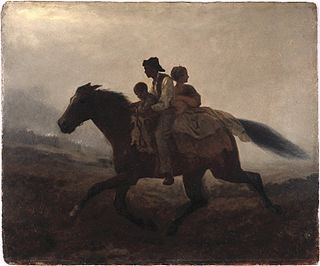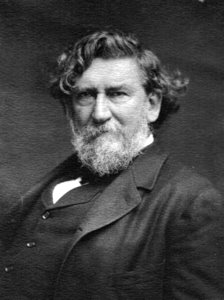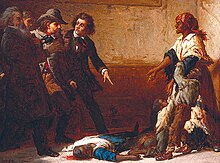
Boone County is a county located on the Ohio River in the northernmost part of the Commonwealth of Kentucky. As of the 2020 census, the population was 135,968, making it the fourth-most populous county in Kentucky. Its county seat is Burlington. The county was formed in 1798 from a portion of Campbell County. and was named for frontiersman Daniel Boone. Boone County, with Kenton and Campbell Counties, is of the Northern Kentucky metro area, and the Cincinnati-Middletown, OH-KY-IN Metropolitan Statistical Area. It is the location of the Cincinnati/Northern Kentucky International Airport, which serves Cincinnati and the tri-state area.

Levi Coffin was an American Quaker, Republican, abolitionist, farmer, businessman and humanitarian. An active leader of the Underground Railroad in Indiana and Ohio, some unofficially called Coffin the "President of the Underground Railroad," estimating that three thousand fugitive slaves passed through his care. The Coffin home in Fountain City, Wayne County, Indiana, is a museum, sometimes called the Underground Railroad's "Grand Central Station".

In the United States, fugitive slaves or runaway slaves were terms used in the 18th and 19th centuries to describe people who fled slavery. The term also refers to the federal Fugitive Slave Acts of 1793 and 1850. Such people are also called freedom seekers to avoid implying that the enslaved person had committed a crime and that the slaveholder was the injured party.

Beloved is a 1987 novel by American novelist Toni Morrison. Set in the period after the American Civil War, the novel tells the story of a dysfunctional family of formerly enslaved people whose Cincinnati home is haunted by a malevolent spirit. The narrative of Beloved derives from the life of Margaret Garner, a slave in the slave state of Kentucky who escaped and fled to the free state of Ohio in 1856.

Clotel; or, The President's Daughter: A Narrative of Slave Life in the United States is an 1853 novel by United States author and playwright William Wells Brown about Clotel and her sister, fictional slave daughters of Thomas Jefferson. Brown, who escaped from slavery in 1834 at the age of 20, published the book in London. He was staying after a lecture tour to evade possible recapture due to the 1850 Fugitive Slave Act. Set in the early nineteenth century, it is considered the first novel published by an African American and is set in the United States. Three additional versions were published through 1867.

Margaret Garner is an opera in two acts composed by Richard Danielpour to an English-language libretto by Toni Morrison. The opera is loosely based on actual events in the life of runaway slave Margaret Garner. A co-commission by the Michigan Opera Theatre, Cincinnati Opera and Opera Philadelphia, it premièred on 7 May 2005 at the Detroit Opera House in Detroit, Michigan with Denyce Graves in the title role.

John Pollard Gaines was a U.S. military and political figure. He was a Whig member of the United States House of Representatives, representing Kentucky from 1847 to 1849, and he served as Governor of the Oregon Territory from 1850 to 1853, stepping down after a turbulent term in office. He was the owner of Margaret Garner, whose enslavement and sexual assault is the basis for Toni Morrison's novel, Beloved.

Partus sequitur ventrem was a legal doctrine passed in colonial Virginia in 1662 and other English crown colonies in the Americas which defined the legal status of children born there; the doctrine mandated that children of slave mothers would inherit the legal status of their mothers. As such, children of enslaved women would be born into slavery. The legal doctrine of partus sequitur ventrem was derived from Roman civil law, specifically the portions concerning slavery and personal property (chattels), as well as the common law of personal property; analogous legislation existed in other civilizations including Medieval Egypt in Africa and Korea in Asia.

Thomas Satterwhite Noble was an American painter as well as the first head of the McMicken School of Design in Cincinnati, Ohio.

Laura Smith Haviland was an American abolitionist, suffragette, and social reformer. She was a Quaker and an important figure in the history of the Underground Railroad.

Henry Walton Bibb, was an American author and abolitionist who was born into slavery. Bibb told his life story in his Narrative of the Life and Adventures of Henry Bibb, An American Slave, which included many failed escape attempts followed finally by success when he escaped to Detroit. After leaving Detroit to move to Canada with his family, due to issues with the legality of his assistance in the Underground Railroad, he founded the abolitionist newspaper, Voice of the Fugitive. He lived in Canada until his death.

The institution of slavery in North America existed from the earliest years of the colonial history of the United States until 1865 when the Thirteenth Amendment abolished slavery throughout the United States except as punishment for a crime. It was also abolished among the sovereign Indian tribes in Indian Territory by new peace treaties which the US required after the Civil War.

The history of slavery in Kentucky dates from the earliest permanent European settlements in the state, until the end of the Civil War. In 1830, enslaved African Americans represented 24 percent of Kentucky's population, a share that had declined to 19.5 percent by 1860, on the eve of the Civil War. Most enslaved people were concentrated in the cities of Louisville and Lexington and in the hemp- and tobacco-producing Bluegrass Region and Jackson Purchase. Other enslaved people lived in the Ohio River counties, where they were most often used in skilled trades or as house servants. Relatively few people were held in slavery in the mountainous regions of eastern and southeastern Kentucky; they served primarily as artisans and service workers in towns.

The Underground Railroad in Indiana was part of a larger, unofficial, and loosely-connected network of groups and individuals who aided and facilitated the escape of runaway slaves from the southern United States. The network in Indiana gradually evolved in the 1830s and 1840s, reached its peak during the 1850s, and continued until slavery was abolished throughout the United States at the end of the American Civil War in 1865. It is not known how many fugitive slaves escaped through Indiana on their journey to Michigan and Canada. An unknown number of Indiana's abolitionists, anti-slavery advocates, and people of color, as well as Quakers and other religious groups illegally operated stations along the network. Some of the network's operatives have been identified, including Levi Coffin, the best-known of Indiana's Underground Railroad leaders. In addition to shelter, network agents provided food, guidance, and, in some cases, transportation to aid the runaways.
George DeBaptiste was a prominent African-American conductor on the Underground Railroad in southern Indiana and Detroit, Michigan. Born free in Virginia, he moved as a young man to the free state of Indiana. In 1840, he served as valet and then White House steward for US President William Henry Harrison, who was from that state. In the 1830s and 1840s DeBaptiste was an active conductor on the underground railroad in Madison, Indiana. Located along the Ohio River across from Kentucky, a slave state, this town was a destination for refugee slaves seeking escape from slavery.
Enslaved women were expected to maintain the enslaved populations, which led women to rebel against this expectation via contraception and abortions. Infanticide was also committed as a means to protect children from either becoming enslaved or from returning to enslavement.
Henrietta Wood was an American women held as a slave who won the largest verdict ever awarded for slavery reparations in the United States. Born as a slave in Kentucky, but freed as an adult, Wood was later kidnapped and sold back into slavery. After the American Civil War, Wood successfully sued her kidnapper and won financial damages.

Peter Farley Fossett was an enslaved laborer at Monticello, Thomas Jefferson's plantation, who after he attained his freedom in the mid-19th century, settled in Cincinnati where he established himself as a minister and caterer. He was a captain in the Black Brigade of Cincinnati during the Civil War. Fossett was an activist for education and prison reform. He was a conductor on the Underground Railroad. His remembrances, Once the slave of Thomas Jefferson, were published in 1898.

Nikki M. Taylor is an American historian. She is professor of history at Howard University and author of four books on nineteenth-century African-American history.
















